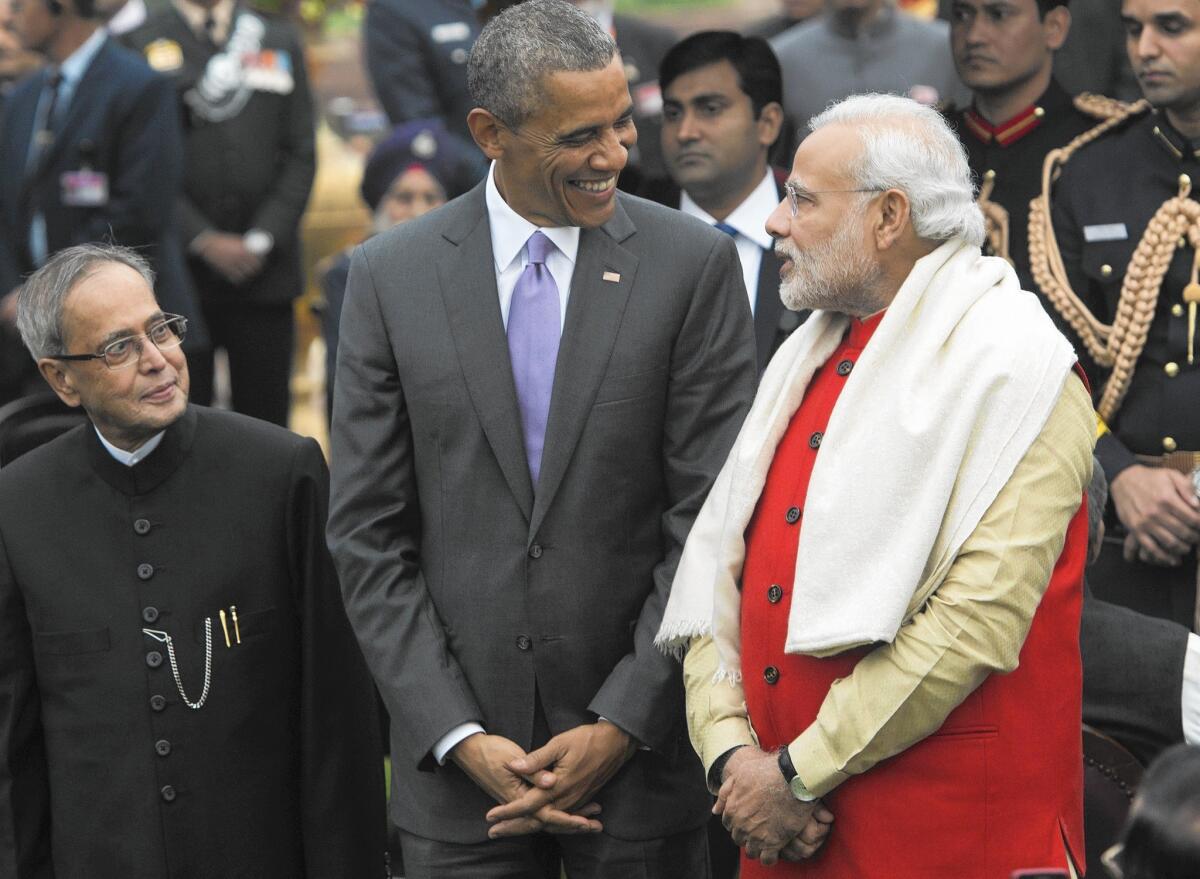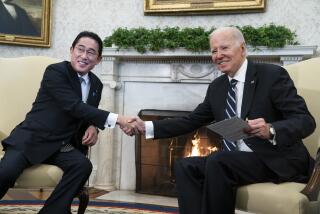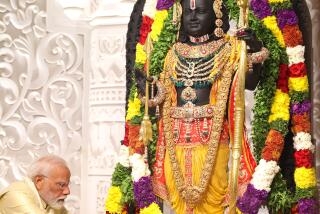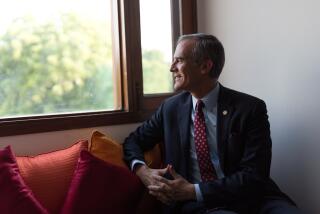White House has high hopes for U.S.-India ‘bromance’

- Share via
Reporting from NEW DELHI — First came a military band riding camels draped in bright pompoms and tiny mirrors. A float carried a giant, snapping crab.
Then the Russian-made tanks rolled by, and Russian-manufactured helicopters flew overhead.
India’s Republic Day parade Monday was both an illustration of its culture and a demonstration of its standing in the world, and taking it all in was President Obama, who had accepted a personal invitation from Prime Minister Narendra Modi to attend.
After years of chilly relations between their countries, the White House is hoping that the growing warmth between the men will turn into a more cooperative relationship between their governments.
The Soviet-style military pageantry illustrated the awkwardness that remains. Even as Modi tries to edge closer to the U.S., India’s traditional orientation remains strong. During a side-by-side news conference over the weekend, Obama criticized Russian President Vladimir Putin while Modi — who has called Putin “a leader of a great nation” — stood by silently.
Later, Indian Foreign Secretary Sujatha Singh responded tersely to a question about Obama’s comments, telling a journalist, “You are aware of our strategic partnership with Russia.”
There are other issues poised to challenge the still-burgeoning Obama-Modi relationship, principally breaking the barriers to trade with India’s $5-trillion economy and, perhaps highest on the Obama administration’s agenda, brokering a major climate change agreement.
U.S. officials acknowledge the hurdles. Despite a lot of overlapping interests between the U.S. and India, it has been hard to “get out of the old habits of mistrust,” said Ben Rhodes, Obama’s deputy national security advisor.
But the White House, which often downplays the effect of personal ties or friction between leaders, says it’s looking to the relationship between Obama and Modi as the key that opens the door to better relations.
“The ability to reach out and go leader-to-leader is ultimately what breaks logjams,” Rhodes said.
The fondness between the popular prime minister still in the dawn of his power and the U.S. president looking at the twilight of his own probably has to do with both political calculations and personal chemistry. Indian analysts say Modi wants U.S. investment to spur economic growth, while Obama sees a refreshed relationship with India as a second-term boost to his flagging attempt to shift the focus of U.S. foreign policy from the Middle East to Asia.
“We knew when Modi was elected there would be an opportunity to at least feel out whether or not there would be the outline or the contours of a deeper partnership,” said Richard Rossow, an India policy expert at the Center for Strategic and International Studies. “Here we are seven months later — I don’t think any of us could have imagined things moving as fast as they have.”
The result has been billed as a “bromance” by Indian media, which zoomed in with intense interest on the president’s reaction to the camels, the weaponry, the lavish and strange floats that cruised before him Monday.
“It’s always good if two leaders know how to engage with each other in a warm manner. It’s certainly better than if they have to labor over it,” said Madhu Kishwar, a professor at the Center for the Study of Developing Societies in New Delhi. “But the hoopla is excessive. They were both ready for a new start.”
The tension between the nations had been personal for Modi. Before his party’s landslide election last year, he hadn’t been allowed to visit the U.S. for almost a decade because the American government blamed him for failing to control deadly religious riots in 2002 when he was head of the state of Gujarat.
But Modi signaled quickly he wouldn’t be holding a grudge. His party does not adhere to a policy of nonalignment, freeing him to seek international alliances. He visited Washington in September, just four months after taking office, and Obama returned the favor more quickly than many expected, making him the first sitting U.S. president to visit India twice.
Aides to the president say the conversations between Obama and Modi are going well. After closed-door sessions Sunday, the two men announced a meeting of the minds on a few matters, including a deal that could clear the way for multinational corporations to build nuclear power plants in India. The two sides released a joint statement of policies in the Asia-Pacific region, in which both expressed cooperation on information sharing and issues related to the South China Sea and North Korea.
And for the first time, the U.S. expressed clearly its support for bringing India into the Asia-Pacific Economic Cooperation forum, the chief trade group in the region.
The steps are incremental. India is part of major trade pact negotiations being led by China, not Obama’s separate, long-sought free-trade deal. And after the parade Monday, when Obama and Modi spoke before a group of business leaders and vowed to encourage greater investment in both countries, the concrete steps to back up the promises were small.
Obama and Modi pledged to ease red tape, regulations and legal hurdles that have prevented the U.S. and India from mining what Obama called “so much untapped potential” in the economic relationship.
The announcements don’t constitute sweeping change just yet, said MasterCard CEO Ajay Banga, who is part of the U.S. delegation.
“All those are signs of progress,” he said, “and of the importance of chemistry.”
In the push to show off this chemistry, Obama has avoided some points of friction. He has not mentioned the concerns that Indian diplomats in the U.S. are skirting labor laws by exploiting domestic help. The issue was highlighted last year when India expelled a U.S. official after an Indian diplomat was arrested on charges in New York that she violated labor laws by lying about underpaying her housekeeper.
Human Rights Watch has also pushed Obama to raise the issues of treatment of religious minorities, gays and lesbians and violence against women.
The closest Obama came on Monday was a call for “inclusive” economic growth. In his remarks before chief executives, Obama gently pushed the group and Indian officials to consider the nation’s poverty and environmental concerns in the rush to develop.
“We need to make sure that economic growth in both our countries is inclusive and sustained,” Obama said. “One of the great potentials for India and one of the great necessities for the world is that we find ways to lift people out of poverty and provide them power in ways that are sustainable and allow you to leapfrog over some of the dirty development strategies of the past directly into the clean strategies of the future.”
Obama has made no leaps on a climate deal during this trip. As India embarks on a period of rapid industrialization driven by fossil fuels, outside constraint on that growth would be “just politically not feasible,” no matter how cozy the relationship between Obama and Modi, Rossow said.
The president and First Lady Michelle Obama braved wet weather to watch the parade — with TV cameras trained on them for reactions in live broadcasts on several Indian television channels.
Sitting next to Modi, Obama watched patiently as Indian regiments marched by. As floats rolled in front of him one after another, he tilted his head close to Modi and asked questions.
He watched without saying much as several armored trucks and tanks rolled by, along with soldiers cradling assault weapons, much of it Russian-made hardware.
At the end of the parade, India’s main arms supplier had its moment. American-made C-17, C-130J and Poseidon aircraft participated in a flyover, albeit escorted by Russian fighter planes, a sign of India trying to strike a balance between an old friend and a new one.
Parsons and Bengali reported from New Delhi and Hennessey from Washington.
More to Read
Sign up for Essential California
The most important California stories and recommendations in your inbox every morning.
You may occasionally receive promotional content from the Los Angeles Times.













